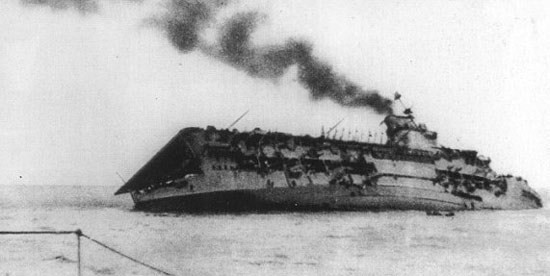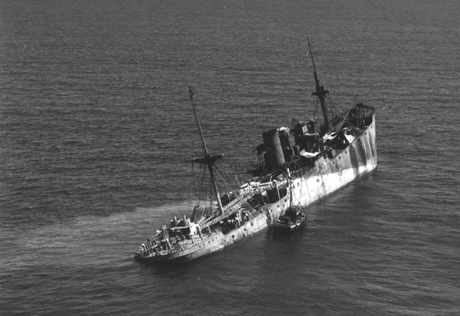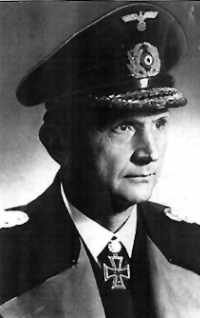The Norwegian Operation and the Torpedo Crisis
by Nickolay Nedelchev
One of the less popular stories about the elite German U-Bootwaffe is the torpedo crisis of late 1939 -- early 1940. Although this was the period during which some of the most outstanding U-boat successes were scored, it was full of bitter disappointments and equally resounding misses as well.
It is a common notion among those interested in the U-boat war that the magnetic firing pistol of the German torpedoes was the 'cause of all evil.' This, however, is only partially true. For the most part, the magnetic pistol malfunctioned against capital warships, or so it seemed. This topic will receive further coverage as our story unfolds.
The first case of torpedo failure took place very early in the war. Immediately after the outbreak of hostilities, the British Admiralty sent several aircraft carriers into the waters west of the British Isles, the important western approaches, as a measure against the penetration of German submarines into the Atlantic and as a protection measure for convoys. Since U-boats relied mainly on surface attacks, ASDIC being unable to detect them on the surface, continuous air patrol was a grave threat to their operational agility. Consequently, U-boats engaged the carriers one-on-one. Well, not really, since the carriers always enjoyed a protective destroyer screen. The odds against which the U-boats fought, therefore, were particularly high on such occasions.
Nevertheless, on September 17 Kapitänleutenant Glattes of U-39 spotted the HMS Ark Royal in his patrol area and was able to close in on her unnoticed. And there occurred the first major disappointment of the U-boat war. Glattes fired a salvo of three torpedoes with magnetic pistols at the carrier, all of which exploded prematurely. Worse yet, the failed attack revealed the boat's position to the escort and the destroyers quickly sank U-39. The crew, fortunately, was saved.

HMS Courageous sinking after U-29's torpedo hits
This particular case did not cause alarm, because it was a rather isolated one. Just two days later Otto Schuhart of U-29 sighted the HMS Courageous in the same vicinity. Drawing upon his own bad experience with magnetic pistols, Schuhart used three fish with impact detonation that all exploded properly. The proud carrier sank within minutes. More importantly, following these two incidents the Admiralty withdrew the valuable carriers (actually it was only the remaining Ark Royal) from the western approaches, which was just what the U-boats needed. The first major engagement between U-boats and British warships, therefore, turned out to be a resounding German success. Carriers were not to appear in those waters again for another four years.
Another isolated instance occurred after Prien's feat in Scapa Flow. As a result of the ignominious loss of the Royal Oak, the British Admiralty decided to evacuate the base. The probable new destinations for the Home Fleet were Loch Ewe (on the west coast of Scotland), Firth of Forth and Firth of Clyde. Also capital ship activity was to be expected in the sea north-west of the Orkneys, or so sensed Dönitz. Accordingly, he dispatched U-56 and U-59 to that latter area with the intention to keep up the pace of the offensive against the Home Fleet's capital warships.
The Admiral was proven once again correct. On October 30th Kapitänleutnant Wilhelm Zahn of U-56 sighted in his area a truly juicy formation: the battleships Rodney, Nelson, the battle cruiser Hood (later blasted by the Bismarck) and a dozen destroyers. With great daring and skill, Zahn eluded the destroyer screen and struck Nelson with a salvo of three. The impact pistol torpedoes clearly slammed against the ship's hull and…simply fell apart. The commander was so depressed by this misfortune for which he was not to blame in the least that Dönitz took him off active duty for a while.
As far as Loch Ewe, Firth of Forth and Firth of Clyde were concerned, BdU dispatched boats armed with magnetic mines, since there was a significant probability that the ships are not at anchor when the boats arrived. Between October 1939 and March 1st 1940 the U-Bootwaffe practically encircled Britain with mines, laying thousands at every more important British port. Captain Roskill, the leading Allied historian of the Naval War during WWII and an author whom Dönitz himself repeatedly quotes in his memoirs, points to a figure of some 115 ships of 400,000 GRT lost to mines in less than 6 months from the beginning of the war. The mines, for a while, became by far more reliable than the defective torpedoes. The mining operations proves so successful that the Thames estuary itself was for a while crammed with ship wreckage. The same lucky Nelson, whom fate spared form Zahn's daring attack, hit a mine off Loch Ewe and, with its hull ripped open, almost sank.
The real torpedo crisis unfolded during Operation Weserübung - the largest amphibious operation in German history, the invasion of Norway. Assisting the surface vessels of the Kriegsmarine and standing guard against interference from the Royal Navy were 8 tactical groups of submarines, comprising a high percentage of the operational strength of the U-Bootwaffe as of April 1940. Those included coastal boats (type II A through D), but also the bigger, ocean-going type (VII A through C). Positioned from Narvik to the Orkneys were a total of 30 U-boats (one group was even deployed in the English Channel). We should distinguish these tactical groups from wolf packs (Rudeltaktik), which did not evolve until several months later.
Thus deployed, the U-Bootwaffe was in position to intercept any British expeditionary force and severely cripple it. However, in fact it failed to do so, and the reason was largely defective magnetic and impact pistols. Here are some of the most notable examples:
When the British Expeditionary Force (BEF) finally set out for Narvik on April 15th, Naval High Command and BdU had a difference of opinions as to where exactly the British will disembark. High Command considered the fjords Lavangen and Gratengen to the north of Narvik most probable. Dönitz, however, believed that the site of disembarkation would be Bygdenfjord, also to the north of Narvik, but at a greater distance. Consequently, he was proven right when late on April 15 Gunther Prien of U-47 arrived at Bydgenfjord and spotted three large British transports (some 30,000 GRT each) and several smaller ones disembarking troops in fishing boats. Immediately the Raging Bull fired 8 torpedoes with impact pistols at the stationary and overlapping targets, but all of them missed. This could have been a major disaster for the BEF and a valuable help for the outnumbered mountain troops defending Narvik.
The previous day, Kapitänleutnant Herbert Schultze of U-48 (the boat that was to become the most successful vessel of the Kriegsmarine with 312,000 tons sunk over almost 6 years) had attacked the Jutland-veteran battleship Warspite without success near Westfjord.
Again on April 19th Gunther Prien closed in on the Warspite and lobbed in a salvo of two. Those, too, were failures, which robbed the Kriegsmarine of a much-needed respite. The second stage of Operation Hartmuth was hardly going well, with British troops closing in on Narvik and the Royal Navy inflicting heavy losses on German warships as well as on troop and supply freighters.
The next day Prien sighted a convoy south-west of Westfjord, but refrained from attacking because he had lost all faith in his torpedoes. Upon his return he was so infuriated that the told Dönitz: "Herr Admiral, I could hardly be expected to fight with a dummy rifle" (89).
|
US National Archives - 12141

A torpedo from U-109 hit the SS La Paz on 1 May, 1942. She did not sink.
|
What were the causes for these stupendous failures? As early as April 11th, Dönitz distributed new orders to the boats participating in operation Weserübung, orders that reflected the accumulation of torpedo failures over the previous two days. At that point, as already mentioned above, it seemed that only impact torpedoes were successful against warships (this conclusion was later disproved by Prien's failure against the British transports). Consequently, Dönitz issued orders that instructed the commanders to rely more heavily on the impact pistol torpedoes. Although the Torpedo Department had assured the Admiral that the proximity of the North Pole in the so-called Zone O (off northern Norway) should not affect the efficiency of the magnetic pistols, magnetic pistol torpedoes quite often detonated the warhead prematurely.
 Admiral Dönitz
Admiral Dönitz
|
The Admiral vehemently set out to track down the reasons for the torpedo disaster and to lend a helping hand to his daring and talented men as fast as possible. After an emergency conference with representatives of Naval High Command and the Torpedo Department, Dönitz concluded that magnetic interference form the fjords did, after all, affect the magnetic torpedoes. It was also found that the essential problem with the impact-pistol torpedo Mark G7e was that its depth-keeping gear ran off base, causing the torpedo to run 6 feet deeper than set depth and simply pass beneath its target. Thus, writes Dönitz, "we found ourselves equipped with a torpedo that refused to function in northern waters either with contact or with magnetic pistols." The compromise decision was to use magnetic firing (Mark G7a) except when near to fjords, where the magnetic pull was considerable and often caused premature detonations.
|
US National Archives - 177195

This one worked. SS Ulysses' boilers seen exploding after
U-160's torpedo hit.
|
A commission was set up in mid-April to investigate the case thoroughly. The commission came out with a comprehensive report in late July, which placed a considerable blame on the Torpedo Department. The TD, it was found, had supplied the boats with the new magnetic firing pistol with four-blade propellers before it had undergone the necessary trials. Consequently, the personnel of the Torpedo Experimental Institute responsible for that SNAFU were court-martialed and sentenced to prison terms.
Although the negligence of the Institute had been established, it was not until February 1942 that the U-Bootwaffe got to the heart of the matter.
On January 30 1942 the crew of U-94 made a little extra effort and conducted an on-board examination of their torpedoes amidst the Atlantic. They thus discovered an excess pressure in the torpedoes' balance chambers, where the hydrostatic valve controlling the depth at which the 'fish' ran was located. When they radioed back their findings, the Inspector of the Torpedo Department ordered a check on board all submarines in port. Half of the torpedoes were found to have the same problem, and the mystery of the torpedoes' deeper-than-set-depth run was finally fathomed. The results of this and later investigations were summed up into a Memorandum by Grand Admiral Raeder on Feb 9 1942.
But what was this higher pressure in the chambers due to? According to Dönitz's memoirs, the higher than normative pressure (the normative was atmospheric) in the chambers was due to the "frequent releases of compressed air which are essential when [the boat] [is] proceeding submerged" (92). During long periods of submersion, a considerable excess pressure thus accumulated. One can't help asking, hadn't the constructors foreseen such a problem? They had, indeed. Normally, no excess pressure should have accrued. However, many balance chambers were found not to be airtight - they had leaks. This discovery, added to magnetic influence from the Norwegian fjords, largely explained the stupendous failure of the boats during Operation Hartmuth, for many of them had remained submerged for as long as 20 hours daily. After the final computations were made, it was found that between 30 and 35 % of the torpedo attacks during the Norwegian campaign had been failures.
In December 1942, well into the war, a new, improved magnetic pistol was introduced which also functioned on contact. It proved very efficient. Until then, writes Dönitz, "the effectiveness of our torpedoes was no greater than it had been during the First World War" (94). Indeed, inter-war naval doctrine called for a single torpedo that would be able to break the back of even a battleship. In fact, far more money was spent on big gunnery research than on torpedo improvement, with the result that when the war broke out, the torpedo that the Navy required existed only in the minds of the complacent Torpedo Department and the Torpedo Experimental Establishment - the monopoly producer and tester of the torpedoes, respectively. Had they had more competition from private industry, we would have had a better torpedo, to put it in Dönitz's words.
Later into the war, in an analysis of torpedo performance in the period January-June 1942 (Paukenschlag and the apex of U-boat activity in American waters - the richest single harvest of the whole war), it was estimated that only 40% of the ships had been sunk by a single torpedo during that period, while the rest had either required two or more, or had escaped after one or multiple hits. In light of the more than two million tons of shipping actually sunk (a third were tankers), it is easy to imagine what could have been the outcome had the U-boats been armed with the weapon they really needed.
Together with the introduction of the new magnetic pistol torpedo, two more innovations were pioneered into the Kriegsmarine, which effectively surpassed any previous German torpedo as well as any Allied countermeasures. The first innovation in U-boat weaponry was a torpedo that, after running a specified distance, began circling. This was quite useful, especially against convoys since the circling run increased the torpedo's chances to pick up another ship if it missed its original target.
The second novelty, delivered to the Navy in September 1942, was the acoustic torpedo, which steered directly at the noise of the target's propellers. It was an extremely useful weapon, because it could be fired from any angle, now matter how narrow a broadside the target presented. This also meant that the U-boats finally had a reliable weapon to fight destroyers, and indeed a number of successes against the latter were eventually scored.
The torpedo crisis was thus ultimately brought to an end, though by that time it was too late. In July 1942, the Allied shipbuilding capacity for the first time surpassed the U-boats' rate of sinking (which was then particularly high). The U-Bootwaffe never caught up again.
Editor's note: The US Navy had very similar experiences with their torpedoes when they began their war in the Pacific.
Sources
Dönitz, Karl. Memoirs: Ten Years and Twenty Days. Cleveland and New York: The World Publishing Company, 1959.Miller, Nathan. War at Sea. New York: Scribner, 1995.
This article was published on 2 Apr 1999.

